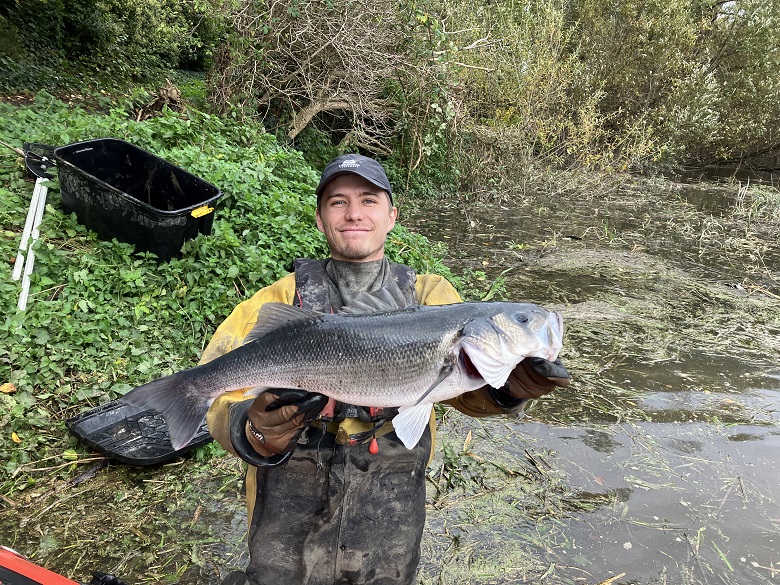Fish thrive in the Channelsea River following the building of the Lee Tunnel

A fish caught and released during the ecological survey on the Channelsea River, November 2022.
- New survey of Channelsea River finds 12 species of fish – a positive indicator of a healthy watercourse.
- There have been no discharges of storm diluted sewage from Abbey Mills Pumping station since the building and commissioning of the Lee Tunnel in 2016.
- Thames Tideway Tunnel, due for completion in 2025, will significantly reduce discharges to the tidal River Thames at other locations, which will further improve the health of the river.
Twelve different species of fish are thriving in the Channelsea River, following the building of the Lee Tunnel and improvements to the river’s health, a new survey has found.
In November, a fish survey was carried out by Thames Water and environmental consultancy, Ricardo PLC, to understand the existing ecology in the Channelsea River, prior to the connection of the Thames Tideway Tunnel to the Lee Tunnel.
The findings show the Channelsea River is healthy and supports a wide variety of fish and other wildlife. In total, 714 fish from 12 different species were captured and measured using three different sampling techniques (fyke netting, seine netting and electrofishing), before being released back into the river.
Among the common bream, juvenile sea bass, roach, dace and perch that were found, the team recorded a 10lb sea bass – a rare find so close to Central London.
The survey was part of Thames Water’s work to prepare for the commissioning of the Thames Tideway Tunnel. The company has been working closely with the Environment Agency to understand how it can continue to protect the Channelsea River from storm discharges.
The Lee Tunnel was built as part of the Thames tideway improvements scheme to handle storm overflows, costing £700million. It is 7.2m in diameter, 6.4km long and runs from Abbey Mills Pumping station in Stratford to Beckton sewage works in Newham. At its peak the tunnel can accept 54 cubic metres per second, preventing Abbey Mills discharging into the small Channelsea River.
Since the Lee Tunnel was built and commissioned in January 2016, the river quality has improved, with no discharges of storm diluted sewage from Abbey Mills pumping station into the Channelsea since 2016.
The improvements have taken place alongside upgrades to increase the capacity of Thames Water’s Beckton sewage treatment works. The site upgrade cost over £600million and now treats 27 cubic meters of sewage per second.
When the Thames Tideway Tunnel is brought into service in 2025, it will also significantly reduce the frequency and volumes of storm discharges to the River Thames.
The survey findings and information on the health of the River Lee and Channelsea River indicate there could be similar further improvements to the health and variety of wildlife in the River Thames, when the Tideway Tunnel is fully operational.
John Sullivan, Head of Tideway Integration at Thames Water, said: “Our aim will always be to try and do the right thing for rivers and for the communities who love and value them. The findings of the Channelsea River fish survey highlight the benefits of building the Lee Tunnel and upgrades to our Beckton sewage treatment works to the waterways in this region. We continue to have an unprecedented amount of investment directed towards safeguarding rivers and streams across London and the Thames Valley and the completion of the Thames Tideway Tunnel will also deliver a huge reduction in the discharges to the tidal River Thames in London and further improve the overall health of the river.”
Steve Coates, Fish Scientist & Principal Ecological Consultant at Ricardo, said: “The results of this survey brought a smile to everyone involved. Finding a 10lb sea bass was quite amazing, I’ve never found a bass that large and that far up the Tideway and/or into the Tidal Creeks in my 31 years of working on the Thames.”
Thames Water’s shareholders have recently approved an additional £2 billion of investment into the business as part of Thames Water’s turnaround plan to improve performance and outcomes for customers, leakage and river health.
The company has also committed to a 50% reduction in the total annual duration of spills across London and the Thames Valley by 2030, and within that an 80% reduction in sensitive catchments.
Thames Water has started a £100 million upgrade of its Mogden sewage treatment works and is currently increasing sewage treatment capacity at a number of its other sewage works across the Thames Valley, including Witney and Fairford to be completed by 2025.
The Thames Tideway Tunnel is the third phase of a comprehensive environmental improvement programme of the tidal Thames for Thames Water customers and river users. It is due for completion in 2025 at a total investment of more than £4 billion. It will deliver a huge reduction in the discharges to the tidal River Thames in London and further improve overall health of the river.
Further information
- The deployment of three differing fish capture techniques during the survey, allowed for the breadth of species, across a range of size ranges to be captured and recorded, before being returned to the Channelsea River.
- The species recorded were common bream, roach, dace, perch, carp, feral goldfish, sea bass, flounder, thin lipped grey mullet and common goby, stickleback, minnow.
- Thames Water and Ricardo are also conducting an invertebrate survey in the river with results expected early next year.
